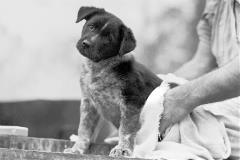Canine Hair Loss - Shedding or Disease?

There are many factors that benefit the quality of a dog’s coat and help to maintain a regular cycle of hair growth. While shedding is often complained about, it is a normal process for most dogs. However, when patients present with excessive hair loss, an examination needs to be completed.
Canine Hair Growth
Depending upon the individual animal and the breed variations, it typically takes about four months for the average dog to grow a coat. Occurring in three stages, the typical growth cycle includes:
- Anagen phase
- Period of rapid growth
- Catagen phase
- Period of slowed growth
- Followed by resting
- Mature hair remains in hair follicles then detaches from the base
- Telogen phase
- Shedding
- Young hair pushes out the older hair; growth cycle then starts over once again
Common Shedding Times for Dogs
Most dogs will shed or blow their coat one time per year, with the most common shedding times occurring due to:
- Hormonal swings, for example following:
- Heat cycle
- Delivery of puppies
- Usually occurs within six to eight weeks
- Seasonal changes
- While many assume shedding is governed by increased temperatures, it is actually the length of daylight that is the greater influence
- In the spring, the amount of daylight increases, activating the shedding process which may be observed to last four to six weeks
- In the fall, in some animals, as the amount of daylight decreases, the process may again be activated and shedding may once again be observed
- Light sensitivity
- Dogs who spend the majority of their time outdoors appear to be more sensitive to ambient light, with shedding more commonly following what seems to be a seasonal change
- Dogs who are housed indoors and primarily exposed to artificial light tend to grow their coats and shed year-round
Indication of a Problem
When hair loss is unrelated to shedding, signs that may indicate a medical problem include:
- Excessive hair loss
- Bald patches
- No symptoms of itching or scratching present
Medical Diseases
The following diseases often present with symptoms, such as hair loss, that are recognized through changes in the animal’s coat and skin.
- Alopecia
- Growth hormone-responsive
- Bilaterally symmetric hair loss
- Mostly occurring in male dogs nearing time of puberty
- Prevalent in breeds, including:
- Keeshonds
- Pomeranians
- Airedales
- Boxers
- Chow Chows
- Color mutant
- Symmetric loss of hair over trunk and body
- May appear with papules and pustules
- Most commonly found in Dobermans
- Growth hormone-responsive
- Cortisone excess
- Seen with Cushing’s syndrome
- Asymmetric hair loss over trunk and body
- Animal often appears pot-bellied
- May be seen in dogs taking steroids
- Hyperestrogenism
- Occurs in females and in males
- Bilateral symmetric hair loss, often around genitals
- Enlarged vulva and clitoris in females
- Pendulous prepuce in males
- Hypoestrogenism
- Occurs in older, spayed females
- Thinning coat, minimal hair growth
- Skin smooth and soft
- Hypothyroidism
- Most common cause of hair loss that presents without itching
- Bilaterally symmetric hair loss
- Coat is thin and falls out easily
- Commonly affected areas include: sides of body, backs of thighs, top of tail, neck beneath chin
- Demodectic mange
- Localized
- Occurs in puppies
- Hair loss gives a moth-eaten look
- Generalized
- Occurs primarily in young adult dogs
- Associated with immune deficiencies
- Localized
- Acanthosis nigricans
- Most common in Dachshunds
- Hair loss initially noticed in folds of armpit and on ears
- Skin appears black, thick, greasy, smells rancid
- Nasal solar dermatitis
- Also referred to as Collie nose
- Affects dogs that have noses with light pigment
- Hair loss occurs at junction of nose and muzzle
- May be attributed to autoimmune disorder
Canine shedding is a naturally occurring process, but in times when hair loss seems excessive, there may be an underlying health issue. For more information regarding canine coat and skin products, contact your Covetrus representative at 855.724.3461.
Sources:
Dog Owner’s Home Veterinary Handbook, 4th ed., by D.M. Eldredge, L.D. Carlson, D.G. Carlson, J.M. GiffinCareers
Are you looking for a place to let your talents shine? At Covetrus, we help our practitioner customers better serve their patients and take pride in providing the best customer experience possible. Search our open positions to see our available opportunities.
Newsletter
Stay current with what’s going on with Covetrus, subscribe to receive our newsletter and email communications. Subscribers will receive the latest information in practice management, sales and marketing, animal health, and more.


Leave a comment